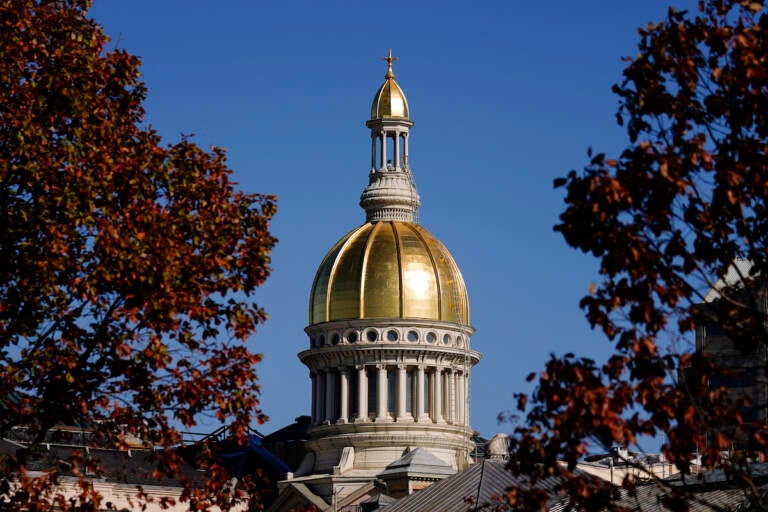Here’s how legislative and congressional redistricting works in N.J. — and what’s at stake
Two commissions are redrawing N.J.’s legislative and congressional district maps. There’s still time for the public to weigh in, so here’s what you need to know.
Listen 1:48
The New Jersey State House in Trenton, N.J., Wednesday, Nov. 10, 2021. (AP Photo/Matt Rourke)
Every ten years, New Jersey’s congressional and legislative maps are redrawn, following the release of U.S. Census data, to ensure there’s equal representation in the U.S. House of Representatives and the state Legislature.
These processes, called redistricting and reapportionment, are currently underway. And they have a big impact on elections in the Garden State for the next decade.
What are reapportionment and redistricting?
Reapportionment is the process of reassigning representation in New Jersey’s legislative and congressional districts, based on fluctuations in population.
State legislative districts are reapportioned to account for population growth or decline on the local and regional level — within municipalities and counties. New Jersey’s state Legislature is made up of 40 districts and is reapportioned at the start of a new decade to make sure each district still has an equal number of people represented in them. New Jersey now has an estimated population of 9.2 million people. That means each state legislative district will represent roughly 230,000 people.
Congressional districts are redrawn to account for overall state population growth or decline at the beginning of each decade. A state can gain representatives if its population sees major growth. Conversely, a state can lose representatives if its population takes a substantial hit, in proportion to other states. Although New Jersey’s population grew by an estimated 500,000 people between 2011 and 2020, according to Census data, the Garden State will not gain or lose a seat in Congress (it currently has 12).
Redistricting is the process of drawing new lines on election maps to account for all of these changes.
After new congressional and legislative maps are drawn, incumbents could end up running for reelection in a different district than they previously served. State legislative candidates must live in the district they serve in.
Who decides how new congressional and legislative maps are drawn?
Unlike in most other states, New Jersey’s maps aren’t drawn by the state Legislature, but by a bipartisan commission.
In fact, the Garden State has two separate commissions: a congressional redistricting commission — made up of six Democrats, six Republicans, and one independent chairperson — and a legislative apportionment commission composed of five Democrats, five Republicans, and one independent member. Members of both commissions are politically appointed.
“New Jersey is actually one of the more transparent and also one of the fairer systems in that it is both bipartisan with a neutral, qualified tiebreaker. And it has lots of opportunities for public participation and transparency,” Brigid Callahan Harrison said, a political scientist at Montclair State University.
Only one member of the congressional commission currently serves in the state Legislature: Sen. Vin Gopal (D-11).
Three members of the state legislative apportionment commission currently serve in the state Legislature: Senate President Steve Sweeney (D-3), Senate Minority Leader Thomas Kean, Jr. (R-21), and Assembly Minority Leader Jon Bramnick (R-21).
Sweeney and Kean are leaving office following the 2021 general election. Many of the other commissioners have experience working in politics or have served as local officials.
Can the public weigh in?
While the commissions’ work of actually drawing those maps is mostly done outside the public eye, people are allowed to weigh in on these processes at public hearings.
The congressional redistricting commission has two public meetings coming up on Nov. 20 and 21. The legislative reapportionment commission has three public meetings on Nov. 23, Dec. 8, and Dec. 10.
For some, it’s a complex subject that takes time and effort to better understand.
“This is definitely something that I’m learning and knowing more about,” said Jasmin Jones, president of Rowan University’s NAACP chapter. “I’ve heard redistricting, gerrymandering before … but I’ve never actually attended a hearing.”
Jones, a senior justice and law student from Mullica Hill, spoke to the panel of congressional redistricting commissioners for the first time during a recent public hearing at Rowan University’s Glassboro campus Monday evening. She asked commissioners to consider keeping Glassboro in the 1st district — fearing that by changing its congressional district, student voices may be drowned out by those who don’t resemble Rowan’s diverse community.
“I just wanted to make it a point that although [Rowan University is] a predominantly white institution, the student population of Black and brown, multicultural students is growing and our impact on our community is growing as well. So I think it’s really important that our voices are highlighted,” Jones said.
Nearly 45% of New Jersey residents are people of color, according to the state’s Office Of Diversity and Inclusion. People of color will make up a majority of the state’s population by 2028, by some projections.
What’s at stake?
Accounting for New Jersey’s growing diversity is a major topic of discussion during this redistricting cycle, said Henal Patel, director of democracy and justice programming at the New Jersey Institute for Social Justice.
“Ten years ago, New Jersey was over 40% people of color. We had one majority Black district, one majority Latino district … We had one district that was a plurality, which means people of color together were over 50% of the population, and that’s it,” Patel said. “So in a state that was at that time, over 40% people of color, 75% of the districts were majority white.”
Patel said while much of the attention around redistricting is typically focused on which political parties could win or lose seats, more needs to be paid to racial equity and to avoid splitting up communities of color so their interests can be represented by lawmakers.
“At the end of the day, redistricting is the foundation of how our democracy works, of our representative democracy,” Patel said. “So it really should be about drawing maps that reflect and best represent the people in this state, and the various communities that live here.”
Avoiding gerrymandering, or the practice of manipulating the boundaries of congressional and legislative districts to favor one party or class, is also a major concern — especially the practices known as “packing” and “cracking.”
According to the Fair Elections Project, packing occurs when one party fits as many of the opposing party’s voters into as few districts as possible. It creates a scenario in which that party wins enormously in those districts, but it doesn’t win many districts overall. Cracking is when the remaining voters of the opposing party are scattered into districts where they have no chance of winning.
Race and class can also come into play, Patel said.
“Packing is when you take an entire community of color and place them all in one district so that they only have enough, say, for one representative, instead of maybe having the ability to have an influence over two or three,” Patel said. “Cracking is where you will take a community of color and split them up in multiple districts, so that they don’t have enough of a voice collectively to be able to have that much influence over their elected official.”
And there’s a new change that will have a big effect on the maps in some parts of the state:
New Jersey Gov. Phil Murphy recently signed laws ending what’s known as prison gerrymandering. Now, incarcerated people will be counted in the legislative and congressional districts where they are from, not where they are being held behind bars.
New Jersey continues to have the highest rate of racial and ethnic disparity in its prison population among U.S. states. In the Garden State, Black people are 12 times more likely to be incarcerated than white people, despite making up roughly 13 % of the state’s population, according to a 2021 report by the Sentencing Project.
According to NJ Spotlight, some districts could see some big population changes as a result, including the 2nd Congressional, which is already the smallest of the 12 and will see its population further decrease by about 9,200 because of the end of prison gerrymandering. That district is currently represented by Democrat-turned-Republican Jeff Van Drew.
Brigid Harrison, the Montclair State political scientist who is also a former Democratic congressional candidate in the 2nd District, is also urging commissioners to redraw maps with election “competitiveness” in mind, to reduce the chance that one party or ideology goes unchallenged.
“[Competitiveness] has all kinds of good outcomes for governments, including increased voter participation, increased efficacy among voters. And it makes incumbent members of Congress act in a more bipartisan manner, and a less kind of hyper-partisan and extremist way,” Harrison said. “In my view, doing that means that we encourage conversations with people who are different from us, and we increase civility and bipartisanship in our country.”
When will the new maps take effect?
Under the state constitution, the congressional redistricting commission must adopt a new congressional map by a majority vote by Jan. 18, 2022. That new map will be in place for the upcoming midterm elections.
Likewise, the legislative apportionment committee must vote on the new map by March 1, 2022. That map was supposed to be in effect already in the previous election cycle in 2021, but the legislative redistricting process was delayed by a year.
In the 2020 general election, New Jersey voters opted for a constitutional amendment to push back the legislative redistricting deadline to 2022, after the COVID-19 pandemic caused delays in U.S. Census data reporting.
That means its implementation was effectively pushed back until the 2023 election cycle. New Jersey state legislators serve four-year terms, except at the beginning of each decade, when they serve two-year terms to account for a map with newly redrawn districts.
WHYY is your source for fact-based, in-depth journalism and information. As a nonprofit organization, we rely on financial support from readers like you. Please give today.






